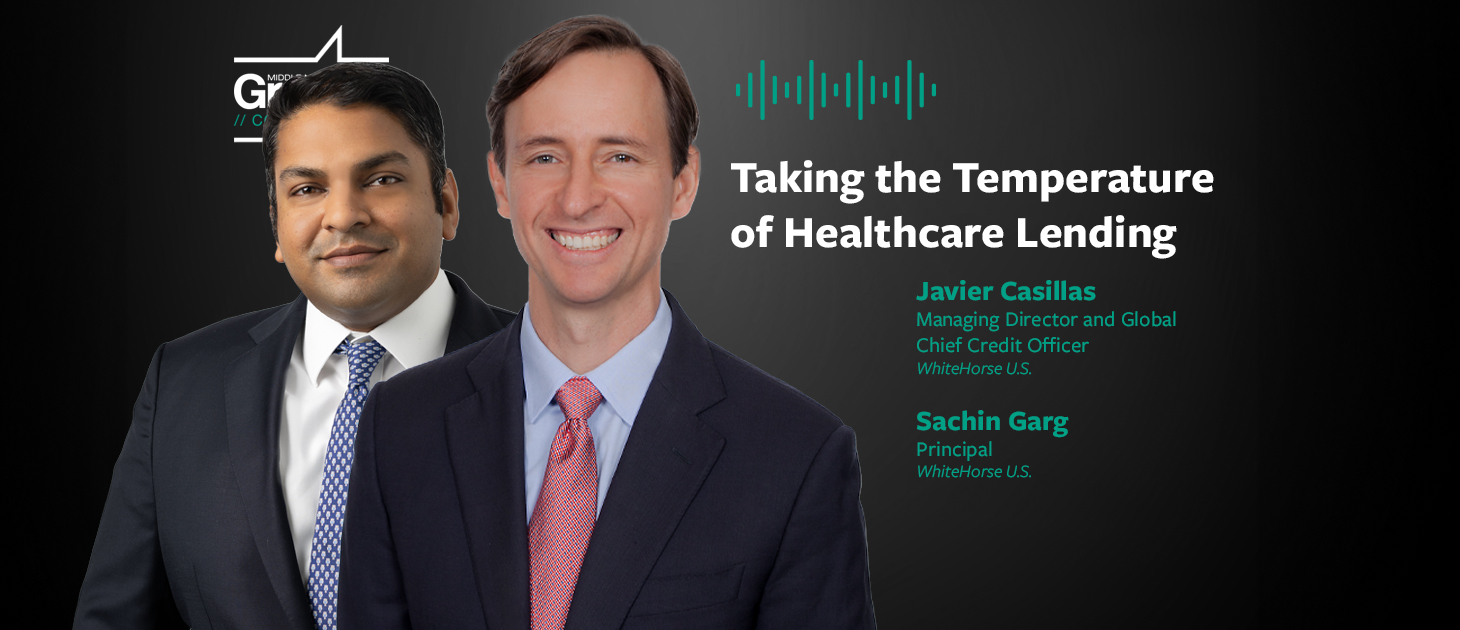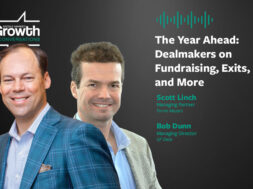Taking the Temperature of Healthcare Lending
Experts from WhiteHorse join the podcast to examine how private credit is evolving in the healthcare space today

Javier Casillas, managing director and global chief credit officer with WhiteHorse Capital, and Sachin Garg, principal with WhiteHorse Capital, join the Middle Market Growth Conversations podcast to talk about the environment for private credit in the healthcare space, the biggest emerging risks and developing lending opportunities.
This episode is brought to you by WhiteHorse Capital, the direct lending arm of H.I.G. Capital. To learn more about WhiteHorse, visit whitehorse.com. Read a transcript of the podcast below.
Middle Market Growth: Welcome to the Middle Market Growth Conversations podcast, an ACG production. I’m Katie Maloney. Today I’m joined by Javier Casillas, managing director and global chief credit officer with Whitehorse Capital, and Sachin Garg, principal with Whitehorse Capital. They are here to talk about the environment for lending and private credit in the healthcare space. Sachin, welcome to the podcast and Javier, welcome back.
Javier Casillas: Thanks, Katie.
Sachin Garg: Thank you. It’s great to be here.
MMG: Now in January, your colleagues Stuart and Pankaj joined us on this podcast to talk about the lending environment shortly after President Trump took office for his second term. Javier, can you tell us how the private credit markets have evolved in the roughly three months since then?
JC: Sure. Happy to. It has been an eventful three months for everybody. I’ll try to stick to things that I’m seeing in our business that might be a little bit different since we’re all kind of reading the same headlines. But one big narrative has been around the resurgence of dormant M&A markets. The hope and expectation had been that those would return an environment of potentially more permissive regulators and generally easier dealmaking conditions. I think what’s actually happened is that there have been countervailing economic concerns around tariffs, growth, et cetera, that have created a big distraction for private equity firms and also lenders focused on their portfolios. And also we’ve been impacted by equity markets, which have been quite volatile, and therefore haven’t really let the valuations blossom at the private equity level to the point where sponsors have decided that they wanted to bring their companies to market. So that’s the familiar narrative, and we’re certainly feeling that.
The other side of that is, honestly, private credit doesn’t necessarily thrive in an environment of perfect stability, and the reason for that is more money can come in. It chases limited deal flow. The spreads compress, and terms can deteriorate. And so when there is what I’ll call reasonable volatility, it actually creates an opportunity for folks that have ample capital, significant underwriting resources, [and] experience having gone through different types of cycles like this. And so it’s been a good quarter for us. Our pipeline remains larger than last year. Our deployments are ahead of last year. The spreads have gotten more interesting, and so I would say it’s a good time to have capital admittedly though it’s not perfect deal making conditions as a function of all the political events and policy events that have taken place in these first few months.
MMG: Great, thank you for that overview of what you’re seeing. Turning to healthcare specifically, Sachin, can you start us off and talk about what some of the biggest risks and opportunities in healthcare private lending look like today?
SG: Sure. Happy to. I think starting on the risk side, the first major concern is regulatory change. Many healthcare businesses, particularly those dependent on government payers, will face exposure to shifts in reimbursement policy, audit scrutiny, or new compliance mandates. Sectors like home health, hospice, and skilled nursing are facing rate adjustments and heightened oversight, which will impact profitability and loan performance. Secondly, operational challenges remain a focus. Labor shortages and wage inflation continue to weigh on healthcare providers, especially smaller ones. Lenders are cautious around businesses with high exposure to labor-intensive models, or those lacking strong back-office infrastructure. On the opportunity side, healthcare’s core resilience remains a draw. Demand for essential services like outpatient care, behavioral health, or home-based services, continues to grow largely independent of broader economic conditions. For lenders, financing companies in these sectors offers exposure to durable cash flows and favorable demographic trends. Finally, consolidation creates additional lending prospects. Many healthcare sub-sectors remain fragmented, and sponsors are actively pursuing roll-ups. This generates steady demand for acquisition, financing, recaps and growth capital—all areas where private credit remains well positioned. In today’s environment, success is largely dependent on sector selection, underwriting discipline, and close monitoring of operational and regulatory dynamics. I think for those lenders that are active in healthcare and willing to be selective and hands-on, the industry continues to offer attractive risk-adjusted returns in the middle market.
MMG: And Javier, anything you’d add there on either the risks or the opportunities?
JC: There are dedicated, very experienced, very successful healthcare private equity groups out there that need to do deals, want to do deals. The challenge, and we’ve seen this at a couple conferences recently, is that they also have a backlog of portfolio companies that have been in there for 5, 6, 7, 8 years, and that require a lot of work. And so even though the volume of certain type of deals, so let’s say PPMs, physician practice management deals, has come down, the expertise in the market remains. And we’re hopeful that that will come back when conditions improve a bit. Those deals will look different. They’ll likely be a little bit lower leverage, the protections will be a little bit better, but I think that those are the dynamics that we’re observing, I guess going back to the earlier conversation around the backlog of deals to be sold versus the ability to focus on new investments
MMG: And Sachin, what types of transactions are your sponsor partners pursuing and which deals are you seeing being brought to market by investment banks?
SG: Yeah, it’s a great question. I would say in 2025, healthcare M&A activity has largely been steady and broad-based. Sponsors continue to drive most of the volume, but non-sponsored activity is increasing. And banks are bringing forth a mix of sponsor-backed platforms, founder-owned companies, and in certain cases, as Javier mentioned, distressed assets to the market. The most common transactions I think that we’re seeing this year are add-ons. Sponsors continue to remain focused on building scale in sectors like dental practices, behavioral health, outpatient care or home health. New platform acquisitions are happening, but I would say sponsors are being more selective, particularly for founder-led companies where they might have a strong regional presence. In some cases, banks are running recaps where physician groups or founders are seeking capital to help support expansion and future growth. On the sell side, sponsor to sponsor secondary buyouts and strategic sales are active, particularly for mature platforms ready for their next growth phase and next ownership group. Valuations remain healthy and buyers are showing interest, but again, are highly focused on compliance, revenue diversification, payor mix and operational resilience. I think that’s a key point, particularly given what’s transpired since 2020. I think sponsors are heavily focused on backing companies that have been able to weather those downturns. Certain segments are attracting both more lender and buyer appetite: PPMs, behavioral health, outpatient surgery and healthcare IT. In contrast, I would say sectors like acute care, skilled nursing and hospice, sponsors remain cautious there, and that’s largely driven by regulatory risks and margin pressure. I would say overall, 2025 is shaping up to be an active year for healthcare transactions in the mid-market. And sponsors and lenders seem to be aligned in the sense that they’re both focused on scalable, resilient businesses and banks are sort of responding to that level of interest and are bringing a wide range of deals across a number of sub-sectors to market.
MMG: And Javier, is there anything you would add to that as far as healthcare sectors that are particularly attractive right now and which might be less attractive from a direct lending perspective?
JC: I think one theme, and this isn’t just in this environment, is a general concept that we focus on here at WhiteHorse, is if the business focuses on efficiency and cost savings, it is much more likely to get support in committee. So Sachin and I just worked on a transaction where the company is delivering a very clear ROI to insurance companies in the form of cost savings, and you just get to avoid the whole conversation around, well, what happens if there’s a reimbursement cut? Or are these prices fair or are patients receiving unfair bills? And so that can cut across a lot of different discrete sectors, whether it’s, you know, pharma services or providers or products. But I would say that that’s a theme that we really like and seek out.
MMG: And Sachin, turning back to you, how have recent economic conditions such as rising interest rates or market volatility impacted healthcare direct lending strategies?
SG: I think first and foremost, financing costs have risen sharply. You know, as base rates climbed over the last few years, debt service burdens increased not just for borrowers within healthcare, but across all sectors. For companies in the middle market, particularly those that operate with thinner margins, this has pressured cash flow. And I think ultimately lenders have reacted to that by changing the way they structured deals. The result has been tightening leverage, higher equity contributions, and perhaps a kind of tighter view on covenants, particularly for those riskier sectors.
In addition, underwriting standards have changed. Lenders are looking more closely at cashflow, durability, compliance infrastructure, and management depth. Going back to what we touched on previously, this means favoring companies with diversified payor mixes, strong revenue cycle management functions, and proven resilience through cycles. For elective driven businesses, lenders are more selective, particularly where patient demand might decrease under economic stress.
And then finally, sector focus has come into play a bit more. Essential services like behavioral health continue to attract lender appetite due to their defensive characteristics. I would say segments heavily exposed to potential regulatory change, like skilled nursing, home health, et cetera, are seeing more cautious credit approaches. Healthcare IT, tech enabled services, and payer services—again, all less interest rate sensitive, also remain strong priorities both by sponsors and lenders. This goes back to a comment Javier made earlier, but market volatility created opportunities for lenders. As banks retrench, private credit funds have been able to step in and finance sponsor backed roll-ups, recaps and opportunistic acquisitions at attractive terms. In today’s environment, I would say private credit providers are balancing caution with backing resilient companies while carefully managing downside risk. Recent economic conditions overall though have reinforced, I think, disciplined underwriting, sector specialization, and specifically having a healthcare dedicated practice as we do at WhiteHorse.
MMG: You touched on this a bit, but I was hoping you could expand on the lessons you’ve learned from lending in healthcare during economic downturns or industry disruptions like the ones we’re experiencing now.
SG: Sure. I think healthcare has proven to be a resilient sector but is not immune from broader economic trends. Across past downturns, I think healthcare has remained relatively stable in non-discretionary services like a primary care or home health setting. But cashflow volatility emerged, certainly in sectors like dental, orthopedic surgery or outpatient services. Lenders, I think, have learned the importance of distinguishing between essential services and those that are elective and to factor that into sector selection.
Secondly, strong management teams and robust compliance have become important differentiators. In stressed periods, healthcare companies with strong management teams and deep benches, good revenue cycle functions and clean regulatory practices were overall better positioned to maintain the confidence of their lenders and ownership groups but also maintain operational stability. Weaker operators, which perhaps had never been through payor audits or had never dealt with reimbursement delays or integration challenges with an acquisition, might have suffered more than those that had been through those issues before. Loan structure discipline has been important. Deals made with lower leverage, tighter covenants, and liquidity protections have generally performed better during downturns. Direct lenders that have maintained conservatism despite broader economic conditions and market conditions, I think were able to ultimately intervene early and work more constructively with borrowers and owners rather than being kind of late and having to take a more reactionary posture.
And then finally, I would say the key trend that we’ve talked about a few times now is really diversification: having multiple service lines, a balanced payor mix, and a broad geographic footprint. Companies with these attributes have been able to weather economic shocks better than narrowly concentrated providers, and lenders that prioritize diversification were able to better manage through these periods of difficulty. I think going into 2025, these lessons remain relevant. Focusing on companies and borrowers that are providing essential services, and then lenders responding to that with disciplined structures, operational quality, and also partnering with the right ownership groups, will all serve folks well as they think through what the next recession might look like.
MMG: And Javier, what advice would you give healthcare companies looking to attract financing from direct lenders in the current market that we’re in?
JC: Sure. I would start with a good answer and an associated reality around the question of compliance and regulatory, you know, especially if you’re in a space that maybe is a little less well understood by the credit markets. So I’ll take something like compounding pharmacies for instance, which we haven’t done anything in, but we’d keep an open mind on. The first question is going to be, what is the compliance function? Who does it? What’s your history of fines, investigations, et cetera? And you need to be really buttoned up on that answer. And ideally, it should be kind of prepped and in a data room somewhere, if that takes five or six days to respond to that’s typically a red flag for us because it means it’s just not a priority for the organization. And in our opinion, it really should be because we see certain types of companies get into trouble with that all the time.
The second thing I would say is to the extent that there’s a big disconnect between your gap financial statements and your actual cash flow, you know, that’s okay. I think that’s fairly normal in healthcare, but please be prepared to explain that bridge, provide data for, et cetera. I think where a lot of borrowers get into trouble is they’ll come to market with a $25 million EBITDA number, and then after a quality of earnings analysis and you know, kind of kicking the tires a little bit, you’ll realize that the company is actually really generating cash EBITDA of maybe half that. And that obviously derails the deal, and it can result in a lot of wasted time and effort by everyone.
And then the third is, a good preparation and response to the extent that you’re dealing with doctors is, what is that alignment? How are those doctors’ lives going to change in terms of distributions, incentives, and equity? Who’s going to step in if there’s more equity needed in the deal? To what extent does that dilute the key providers in the enterprise? And just be really thoughtful about how you’re structuring that on the front end.
As I mentioned earlier, there are a lot of very talented, very successful healthcare specialists in the private equity world who do that for a living. And those tend to smooth the transaction due diligence processes. But I would say that there are also a lot of investors that are playing in this space for the first time, let’s say they’re creating a deal of a dental rollup. Maybe those answers or those concepts aren’t as clear, and it is much better to deal with those upfront, and that might result in difficult conversations and negotiations with your stakeholders, but it’s going to end up with a better financing process, and ultimately a better outcome at the end of the day.
MMG: Great. Thanks for that, great advice. To close us out, Sachin, can you talk about how lenders should evaluate and manage risks unique to healthcare lending, such as regulatory risks or reimbursement exposure?
SG: Sure. I think when direct lenders are evaluating healthcare companies in the mid-market, they have to take a somewhat unique approach to risk assessment that includes both considering regulatory risk and reimbursement exposure. So first I think lenders, specifically healthcare-focused lenders, conduct deeper diligence on revenue sources, right? So first, it’s understanding whether revenue comes from Medicare, Medicaid, commercial insurance, or private pay. Companies that are heavily reliant on government reimbursement are scrutinized more closely and changes in rates or regulations can obviously materially impact cash flow. Generally speaking, lenders favor businesses with some exposure to private insurance or direct payments from patients as a hedge against public reimbursement changes.
Second, regulatory compliance is a major focus. You know, one key area of our diligence requires borrowers to demonstrate a strong compliance infrastructure, billing integrity, licensing, credentialing, and audit preparedness are just some examples. And in more sensitive sectors, we will also review not only internally, but perhaps with a third-party partner, survey results, audit findings, and ongoing monitoring programs. Companies with clean compliance histories and robust policies are viewed as lower risk.
And then finally, I would say lenders assess sector-specific policy risks. So, for example, if a borrower operates in hospice or skilled nursing, lenders will evaluate recent regulatory developments like staffing mandates, broad crackdowns or payment reform. And then just a side note to this, I think a key point is that risk management continues after closing the deal as well. We, particularly at WhiteHorse, like to stay engaged through not only monitoring regular financial reporting and compliance certificates, but also in higher risk sectors, we might require periodic updates on audits or licensure status or any regulatory inquiries. Our belief is that if early warning signs emerge, proactive dialogue with management teams and ownership groups can help to mitigate issues before they escalate. And so I would just say in conclusion, the best borrowers that we see in healthcare demonstrate not only strong financial fundamentals but also place a strong emphasis on compliance and operational discipline. We value the sector’s long-term growth, but there are unique risks that also present themselves within healthcare, and tailoring diligence, structuring terms, and maintaining a strong focus on ongoing portfolio management and monitoring are just some ways to mitigate that risk.
MMG: Okay. We’ll wrap things up there. Javier and Sachin, I really appreciate your time today and the overview of the healthcare lending environment. Thank you so much for joining me on the podcast.
JC: My pleasure. Thanks, Katie. Enjoyed it.
SG: Thanks, Katie.
This transcript was prepared by a transcription service. This version may not be in its final form and may be updated.
The Middle Market Growth Conversations podcast is produced by the Association for Corporate Growth. To hear more interviews with middle-market influencers, subscribe to the Middle Market Growth Conversations podcast on Apple Podcasts, Spotify and Soundcloud.


